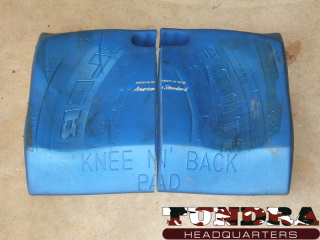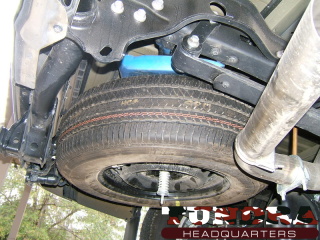 All Entries in the "Tundra News" Category
All Entries in the "Tundra News" Category
Toyota To Make Instant Fuel Economy Gauge Standard
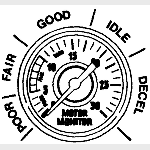 Anybody remember the “motor minder vacuum gauge”? It measured the amount of vacuum in the intake manifold on a carburated vehicle. The more vacuum in the intake manifold, the less fuel being burned (and thus the better your fuel economy). So, if you watched the vacuum gauge while you drove and tried to keep it as high as possible, you could improve your fuel economy. They were fairly common in the early 70s, but they mostly disappeared in the early 80’s when electronic fuel injection made them obsolete.
Anybody remember the “motor minder vacuum gauge”? It measured the amount of vacuum in the intake manifold on a carburated vehicle. The more vacuum in the intake manifold, the less fuel being burned (and thus the better your fuel economy). So, if you watched the vacuum gauge while you drove and tried to keep it as high as possible, you could improve your fuel economy. They were fairly common in the early 70s, but they mostly disappeared in the early 80’s when electronic fuel injection made them obsolete.
Fast forward to 2008.
Many vehicles now feature an instant fuel economy gauge, including the Tundra. If you’re fortunate enough to have one, you know that your truck gets TERRIBLE fuel economy under hard acceleration (try 1-2mpg), but TREMENDOUS fuel economy while coasting (like 80mpg). If you watch it closely, and change your driving habits, you’ll improve your gas mileage.
Toyota reports on their Open Road Blog that Prius drivers who watch their “instant fuel economy reading” achieve 5-10% better fuel economy than drivers who don’t watch it. This evidence is so compelling that Toyota will make instant fuel economy gauges standard on all their vehicles in the next few years, calling the gauges “Eco Drive” indicators.
The “Eco Drive” will include some sort of graph showing how efficient your throttle position is, an indicator that would light up when you’re driving efficiently, and a constant instantaneous fuel economy reading.
Sounds like a nice feature. Toyota is always “moving forward”, aren’t they…
For more Tundra fuel economy information, see the following posts:
What’s with the Tundra’s gas tank reserve? According to my calculations, I’m only getting 10mpg!!
Disappointed in your new Tundra’s fuel economy?
7 Tips for better Tundra gas mileage.
Which gas is better for your Tundra – Premium or Regular?
Search terms people used to find this page:
- tundraheadquarters
Possible Bed Bounce CURE
Great news! One of our readers, Matthew Davis, has come up with a way to dampen and CURE the Tundra’s bed bounce cheaply and simply — check out his full explanation and PICTURES below:
Hello everyone. I am the owner of a 2007 Tundra double cab 4X4 with the 5.7 engine. I have noticed the bed vibration since shortly after purchasing the truck in July. I had some time on my hands the other day, so I got up under the truck to see if I could identify the source of the vibration. Those of you who own this truck can go and grab the rear bumper and shake it up and down vigorously and you will observe independent motions of the bed and the cab. I began to realize that the frame of this truck has a harmonic frequency with a pivot point between the engine/transmission area and the rear axle area of the frame. (Visualize a guitar string.) You can get into the bed of the truck and stand directly over the rear axle and jump up and down, and you will find that it is almost impossible to make the same vibration that you can easily achieve by applying pulsating pressure to the bumper or open tailgate.
I thought about the idea of attaching some sort of weight to the rear bumper area, but as I considered the idea, I realized that this would only change the frequency of the vibration, but would not necessarily dampen it. It might even make the vibration more intense in the cab. So I thought about the idea of somehow canceling out the harmonics of the frame by creating a dampening device with a slightly different harmonic frequency attached to the area of the frame behind the rear axle as close to the bumper as possible. The logic here is that if you could CAUSE the frame to vibrate from this point, then it should be possible to DAMPEN the vibration from the same point.
I decided to use the spare tire for this purpose so as not to increase the weight of the vehicle. I lowered the spare tire a few inches from the frame, and I cut out two pieces of high density rubber foam and placed them in between the tire and the part of the frame that the tire is pressed against. (I used one of those kneeling pads that you use for working on hard surfaces on your knees.)
The pad:
(Click for larger view)There are four points at which the tire contacts the frame. I placed the foam on the rear points and let the front portion of the tire remain in its original position against the brackets that prevent the tire from moving forward. I then re-tightened the tire to where the foam was snug between the tire and the frame. (The tire should be tight enough that it does not rattle.) The tire holder at the end of the cable is spring loaded so it will accommodate some slight movement. This setup allowed the tire to
Latest BorgWarner Tech in the Tundra
From a BorgWarner.com press release, I found this interesting:
BorgWarner Morse TEC’s latest HY-VO(R) four-wheel drive chain technology debuts on the 2007 Toyota Tundra and a new luxury SUV scheduled for release in early 2008. Developed to provide best-in-class sound quality and strength, the technology allows car makers to quietly transfer more power without expanding the size of the transfer case.
‘Four-wheel drive applications increasingly demand greater durability while drivers expect quiet comfort in the cab,’ said Alfred Weber, President and General Manager, BorgWarner Morse TEC. ‘Morse TEC’s technology delivers both, without increasing weight. This contributes to better fuel economy, reduced emissions and improved performance.’ I know where is download 4k films 4kmovies.co here.
The Morse TEC HY-VO(R) chain product line has been powering automotive products for over 40 years. Customers have shown their confidence in the continuous innovation of the HY-VO(R) product line by employing hundreds of millions of HY-VO(R) chains in transmissions and transfer cases around the world.
The New 2008 Sequoia Is A Tundra In SUV’s Clothing
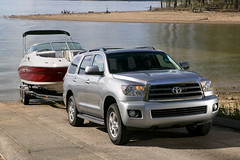 Today, Toyota unveiled the new 2008 Sequoia. As expected, this new SUV is based on the Toyota Tundra. It bears a similar front end, the same powertrains, and a very similar option list. However, there are some key differences:
Today, Toyota unveiled the new 2008 Sequoia. As expected, this new SUV is based on the Toyota Tundra. It bears a similar front end, the same powertrains, and a very similar option list. However, there are some key differences:
The Sequoia will ride nicer: Unlike the Tundra, the Sequoia boasts a fully independent suspension both front and rear. Also, unlike the Tundra, the Sequoia has an “Active Variable Suspension System” option that allows for electronic tuning of the ride using an air suspension system. Additionally, the new Sequoia is supposed to have a slightly different frame. Most likely, it’s a minor difference but we won’t know for sure until we can look underneath one.
The new Sequoia will be quieter: From additional sound dampening materials to a special emphasis on reducing intake and exhaust sounds, the new Sequoia will make less operating noise than the Tundra…as if we care. First thing we’d do is add a dual exhaust.
 The new Sequoia has a few more interior niceties: Second row heated seats, air conditioned front seats (warm or cool air is blown thru perforated holes in the seat surface), and a new “Red Rock” interior color scheme that’s similar to Ford’s “King Ranch” package are all available on the new Sequoia. Like most SUV’s, the new Sequoia also offers rear zone climate controls and a rear seat roof-mounted DVD player. The instrument panel and dash layout in the new Sequoia seems to be pretty similar to the Tundra, but we’ll have to sit in one to know for sure.
The new Sequoia has a few more interior niceties: Second row heated seats, air conditioned front seats (warm or cool air is blown thru perforated holes in the seat surface), and a new “Red Rock” interior color scheme that’s similar to Ford’s “King Ranch” package are all available on the new Sequoia. Like most SUV’s, the new Sequoia also offers rear zone climate controls and a rear seat roof-mounted DVD player. The instrument panel and dash layout in the new Sequoia seems to be pretty similar to the Tundra, but we’ll have to sit in one to know for sure.
As far as features they have in common, the new Sequoia has the same engine and transmission, brake system, integrated tow hitch, and the interior dimensions in the first two rows seem remarkably similar. Additionally, the new 2008 Sequoia is rated to pull 10,000lbs. That’s quite a bit for a full-size SUV – about 1,000 lbs more than the nearest competitor.
We’ll keep you updated on this new sibling of the Toyota Tundra, but you can expect to see them in stores as early as one month from now.
Tundra Tailgate Problems: Toyota Internal Memo
We’re not sure if this is will be old news to some of you, but Toyota released a memo to their dealers regarding problems with Toyota Tundra tailgates in the last week or so. We finally got our hands on it, and you can read the memo for yourself by clicking on the image below.
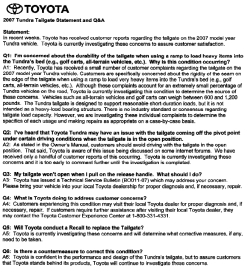
Click image to see full-size memo. Make sure to hover over full-size image when it opens – your browser may shrink it.
The memo speaks for itself, but we thought the phrase “there is no industry standard or consensus regarding tailgate load capacity” was especially interesting. The way we read that sentence, it sounds like Toyota is saying “we can make this truck any way we want to.” Hardly seems like an appropriate response, especially considering the truck is advertised as being the toughest thing on the road.
Here’s an idea: Make the tailgate strong enough so that the welds don’t split when someone loads an atv in the back.
As for the Tundra’s tailgate popping off it’s hinge if you drive with it “down” position, Toyota’s official response is that the manual states you shouldn’t drive with the tailgate down unless it’s secured in that position by the load or a bed extender. Too bad that Toyota’s stance ignores the fact they’ve advertised using the truck with the tailgate down:

Click on the picture to see the full-size image. Look at the sentence towards the bottom to see where Toyota advocates driving with the tailgate down. Thanks again to Glenn for bringing this issue to light.
As far as recalling or replacing tailgates, Toyota says they’ll investigate. Translation — if you make a big enough stink about it, you might get some consideration. If you want to know the best way to create a stink, checkout our Toyota Customer Service Tips post.
